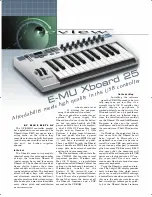
Edit Synt1-Sound
<2> Octave: 8
Edit Synt1-Sound
<3> Detune: 0.38
Edit Synt1-Sound
<4> Glide: 127
Edit Synt1-Sound
<5> Monophon: ON
Edit Synt1-Sound
<6> EGP-Mod: +24
Edit Synt1-Sound
<8> EGP-Dec: 113
`
Press the right-hand PAGE-Key once more. This brings you to page 2 of the menu. The parameter on
menu page 2 allows you to set the octave range of the sound. Four different basic ranges are at your
disposal. '8' means the pitch of the sound remains the same. '4' is one octave higher. '16' is one oc-
tave lower, etc.. Changes are made with the VALUE/TEMPO-dial or the Keys OCTAVE-UP and OC-
TAVE-DOWN in the oscillator section.
Pressing the right-hand PAGE-Key once more will bring you to page 3 of the edit menu, the detune
page. Here you can individually detune the oscillators of the Sirius. The intensity of the de-tuning of
the oscillators can vary from a fraction of a tone to a pitch difference of 24 semi tones (2 octaves).
You can either use the DETUNE control in the oscillator section or the VALUE/TEMPO-dial.
On page 4, the Sirius offers you the possibility of polyphonic portamento. In the oscillator section the
glide-value (or "portamento-time") can be set with the GLIDE-control, values ranging from 0 to 127.
When you play a chord or note in the lowest octave of the Keyboard followed by a chord or note in
the highest octave you can clearly hear how the pitch glides smoothly "to the top".
On page 5 of the menu you can determine if this Part in the Sirius should be played polyphonically
or monophonically.
Polyphonic is the term used for a sound which can be played with many notes simultaneously, suit-
able for playing chords - monophonic is a sound which can only be played one note at a time.
Some parts benefit greatly from being in the monophonic mode.
Turn the parameter to the ON-position. Hold one note down in the highest octave of the keyboard
and play a tune in a lower octave. When you release each note of the tune being played, the high
note which you are holding down will play out.
Page six brings you to the Pitch Envelope Generator. This determines how the pitch of the original
waveform (sound) will be changed over time.
A negative value will make the pitch rise up to the note you have pressed. Positive values will have
the opposite effect. Try it and hear for yourself! The values range from -63 -> +63 and are changed
using the VALUE/TEMPO-dial. This parameter is particularly useful for creating siren sounds, or to
give the glissando characteristic of, for example, a brass section surging into the opening phrase of
'The Stripper'!
On pages 7 and 8 you can time the attack and the decay phases of the pitch envelope. A long attack
means a slow gliding / sliding of the pitch up or down. The decay-phase begins as soon as the origi-
nal pitch is reached.
The Pitch-Envelope Generator (EGP):
The Synthesizer
23
OCTAVE-UP
OCTAVE-DOWN
















































